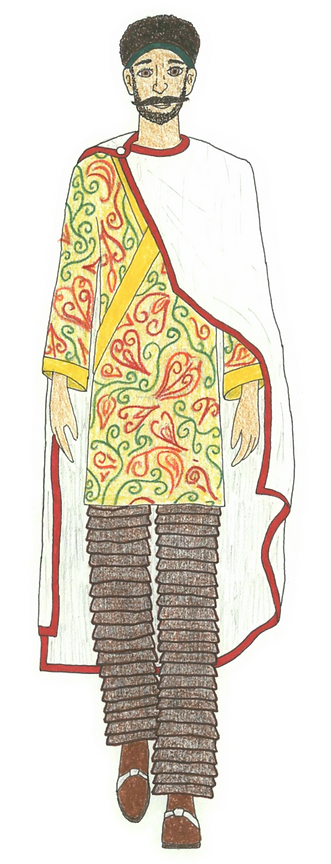“The Parthian Merchant” (Classical Period, 100 BCE – 0 CE)

Our first traveler is a Parthian merchant who traded along the Silk Road between Xi’an and Antioch at the brink of the common era. The Parthian Empire, also known as the Arsacid Empire, was a powerful kingdom of Persian descent in west and central Asia from the third century BCE to the third century CE. The Parthians played a crucial role in intercontinental trade, as they controlled the routes between China and Europe. Most of what we call the Silk Road connecting the East and West ran through this empire. Parthia was a largely feudal society and focused on building roads and monuments with the affluence they gained through their trade control.
Parthian clothing was consistent throughout the empire, especially for the wealthy. Most men wore a tunic as well as trousers that fit loosely and featured horizontal pleats. Some nobles wore extremely wide-legged trousers with ornamental coins, but because our merchant is a working man, I chose to depict him with a more practical straight-cut, undecorated pleated pant. Aside from clothing, Parthian men donned mustaches, short beards, and mid-length hair with a headband. Additionally, our merchant, like many Parthians, wields a concealed dagger for self-defense. These daggers are recorded as having iron blades with bronze handles featuring ridges and a decorative crescent shaped pommel.
Our merchant likely traded with the Scythians, nomadic people in central Asia originally from Iran who connected Chinese trade with the Parthian Empire. While trading between empires, the Scythians were simultaneously attacking Persia. This is a common theme throughout time: cultures at war continued to trade with each other.
Xi’an, a Chinese capital city under the Han Dynasty was the eastern terminus of the Silk Road. Here, the Chinese traded silk for items gathered throughout Europe and Asia. The Han dynasty came to power in China in 206 BCE when they overthrew the culturally oppressive Qin dynasty. The Han dynasty brought a renaissance to China, focusing on music, infrastructure, record-keeping, and Confucian ideals. The roads built under the Qin and Han Dynasties further facilitated trade along the Silk Road.
Despite the major cultural shift from Qin to Han, the Chinese clothing style relatively stayed the same from centuries prior. Clothing had been used as a status symbol and the “shenyi,” or one-piece style of dress remained in popularity. During the Han dynasty, two distinct attributes became core features of Chinese clothing: wide sleeves and the cross-over collar. In his trade with East Asia, our Parthian merchant acquired a silk robe displaying these characteristics, featuring an embroidered pattern of the period. Floral embroidery was not unfamiliar to the Parthians, so the design of this robe has some synergy with his culture’s aesthetic.
Land travel and trade at this time included river transportation as well as the use of camels. Along trade routes, trading posts called “emporia” were used to sell, trade, and store cargo. These emporia stretched as far west as Antioch on the eastern Mediterranean. This is where goods from Asia were traded with Romans.
The Roman Republic was the most powerful and well-known culture of the classical period. Through their military might, they dominated Europe, stretching their empire further than any European power had before. Roman government regulated virtually every facet of citizens’ lives. Culturally, Rome was heavily influenced by the legacy of the Greek, or Hellenistic, culture.
Roman clothing of the upper classes was heavily influenced by that of the Greeks and Etruscans that preceded them. Since the empire stretched to various climates, the Romans made use of seasonal dress. Generally, men wore some form of a wool tunica (tunic) and a wool lacerna (cloak). Large woolen togas were also popular, but only worn by Roman citizens. I chose to depict our merchant with an “equestrian” style cloak since he likely spent most of his time on horseback or camelback. Additionally, although most Romans wore the “carbatina” style of sandal, I depicted our merchant sporting “gallicae” closed boots meant for poor weather conditions.